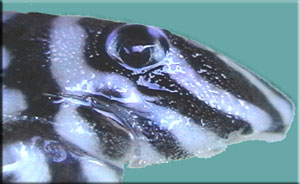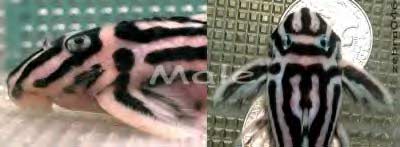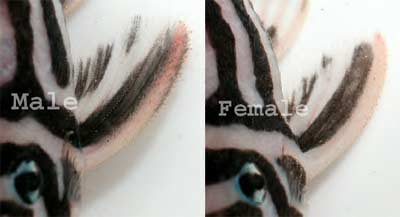| Introduction |
| As you have probably realised, the amount of information available on this fish in its natural habitat is constantly improving. Therefore the species information is limited to what we have collected in captivity and our wider knowledge of the genus. The following table will allow you to familiarise yourself with the basics. |

Close-up of a 3-4 year old male |
|
| Family |
Loricariidae |
| Genus |
Hypancistrus |
| L-Number |
L046, another variation, L098, exists, this is a colour morph. |
| Average Adult Size |
70mm - 100mm |
| Description |
Black stripes running along the white body in the lateral direction. The dorsal fin has a has a high expansion and can develop a "blue tinge" when in prime condition. The pectoral fins have well developed rays, - for some reason these quite often become a little damaged in captivity, this could be due to territorial disputes). The characteristic sucker mouth has 4 "whiskers", and exceptionally sharp teeth. |
| Feeding Habits |
Unlike many plecos, or at least the common perception of them, Hypancistrus zebra is not a herbivore. It is an omnivore, which means it will eat both vegetable
matter and meat. Most fish are relatively fussy however and will develop their own preferences, although it is important to vary their diet. A good selection of food can be:
- Frozen
Blood worm - preferably gamma radiated)
- Frozen
Brine Shrimp - preferably Gamma radiated)
- Live
Bloodworm or Brine Shrimp, - although these can carry
parasites)
- Peas,
- crushed with the skin removed)
- Courgette,
- or as it also known Zucchini or Baby Marrows). I prefer
to par boil mine just to soften them up a bit.
- Tetra
Prima
- Sometimes
Algae wafers
Zebras
seem to prefer to eat at night, but with a strict feeding
regime you will find they will come out whenever it is feeding
time.They do not compete well for food, so it is not wise
to keep them with fish that can be slightly aggressive
or greedy! |
| Behaviour |
Zebras
can be very shy, reclusive fish. It is therefore important
to provide with lots of areas where they can form their
own territories and hide. You may find it takes quite
some time before they stop disappearing into their caves
whenever you enter the room.
They
can be very territorial towards their own species, which
can lead to quite viscous attacks by the alpha male. SO
make sure there are plenty of caves!
Due
to the timid nature of the zebra, it find it difficult
to acclimatise to captivity. It is very common for them
to die of starvation when first introduced. Try and feed
them well in quite spots where they can feed without feeling
threatened. |
| Sexing |
| The male has definite odontodes, or hairs on the pectoral fin, the head is also slightly less rounded. Images courtesy of zebra046. |
 |
| The female has a more rounded head, and finer hairs on the pectoral fins. Images courtesy of zebra046. |
 |
| Here the hairs can be seen easily. Also the pectoral fin is slightly more crescent shaped on the female than the male. Images courtesy of zebra046. |
 |
|
| More Info |
Species profile on PlanetCatfish.com |





